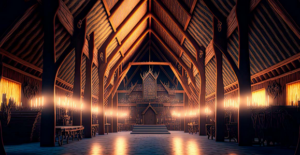In the historically rich soil of Brandenburg, Germany, archaeologists have unearthed a colossal Bronze Age building, thought to be the fabled meeting hall of King Hinz, a legendary figure purported to be interred in a golden coffin. The Brandenburg State Office for Monument Preservation confirmed the finding of the hall near the royal grave at Seddin, raising speculation and excitement about its connection to the enigmatic ruler.
Extraordinary new discovery: a Bronze Age hall unearthed near the so-called royal tomb of Seddin, north of Berlin. It’s the largest known building of its kind from the Nordic Bronze Age (ca. 2200-800 BC)https://t.co/NnL8ZPaQvs pic.twitter.com/F1udp8opYg
— Nina Willburger (@DrNWillburger) November 2, 2023
The Hall of Legends
Spiegel reported that the discovery of the hall, measuring an impressive 31 by 10 meters (102 by 33 feet), was announced by the state archaeologist Franz Schopper as a “spectacular find.” The excavation, led by Immo Heske from Georg-August University of Göttingen, began in March and reached completion by fall. This structure is a rare architectural gem from the Nordic Bronze Age, dating back nearly 3,000 years, with only two others known in the area spanning from Denmark to southern Germany.
Archaeologists found the lost “Book of the Dead” buried in an Egyptian cemetery
Researchers were captivated by the hall’s dimensions, suggesting it served as a palatial residence. The construction techniques speak volumes about the era’s craftsmanship, with walls of wooden planks, wattle, daub, and clay plaster, topped with a thatched roof. Inside, a central fireplace and an unearthed miniature vessel, likely used in rituals, add to the hall’s aura of mystery and historical importance.
Continue here: Ancient Origins
Ask me anything
Explore related questions





